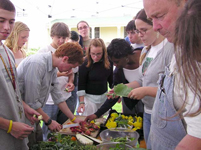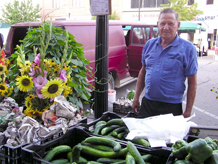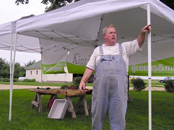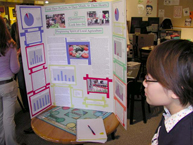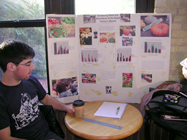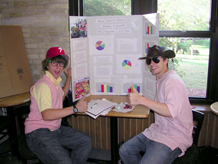Marion Field Fass, Sc.D., Professor of Biology and Chair, Health and Society, Beloit College
A 2007 SENCER Model
Abstract
Slow Food is one of the First Year Initiative (FYI) Seminars offered at Beloit College. These courses are full semester, non-disciplinary, discussion-based courses that emphasize the development of college learning skills including reading, writing, presentation and critical thinking. The instructor also serves as the academic advisor for the students during their first 3 semesters at Beloit College.
The course begins with the questions that the international Slow Food movement has raised about the impact of globalization on our food supply, the cultural and economic choices involved in food consumption, and the loss of biodiversity. Students explore our “foodshed” and what foods are available locally and globally, as well as the impact of food production practices on the environment. Finally, they investigate programs to alleviate hunger and “food insecurity” at home and globally.
Survey design, data, collection, graphing, nutrition and metabolism, and energy are addressed and active learning pedagogies are employed. From the collaborative construction of the Farmer’s Market questionnaire and its analysis to the final research project on global hunger, students spend at least one of every two class hours working in small groups with the teaching assistant and the instructor.
The course is continually being revised with the goal of enhancing the science content and the author hopes to use sessions at the SENCER Summer Institute to explore the incorporation of new topics that demonstrate the intersection of science and policy, including: sustainability, the implications of corn-based food economy, the use of fertilizers and pesticides and growth, and the virtues of organic food versus local food.
Learning Goals
Objectives: Students will be able to:
- Analyze why we eat what we eat in terms of the contributions of:
-
- Cost
- Taste
- Convenience
- Culture, comfort
- Corporations
- Analyze the path of selected foods from producers to tables
- Evaluate changes in the diet of Americans (in the last 100, 50, 20 years) and their impact on nutrition and the economy
- Critique how the American diet impacts global economies and how the American economy affects global diets
- Analyze the links between food and the local economy –
-
- Who benefits from agriculture?
- How does our food availability compare to other cities, other nations?
- Can people in Beloit afford to eat well?
- Evaluate the contributions of NGOs to alleviating hunger and creating a sustainable foodshed and make informed decisions about their value
Linking Science and Social Issues
This course is one of the First Year Initiative (FYI) Seminars offered at Beloit College. These courses are full semester, 4 hour courses but are non-disciplinary.
This First Year Initiative Seminar course begins with “Slow Food,” asking questions that the Slow Food movement poses about the costs of the globalization of our food supply and the loss of biodiversity. Slow Food works as a theme because of its obvious contrast to “fast food” and the images effectively presented by Eric Schlosser in Fast Food Nation and the recent eponymous film. This course addresses the multiple questions embedded in “why do we eat what we eat?” We focus on nutritional needs, asking not only what are needs are and why, but how do we know what we know. We can investigate our “foodshed” and what foods are available locally and globally, as well as the impact of food production practices on the environment. Finally, we investigate programs to alleviate hunger and “food insecurity” at home and around the world.
What is the Slow Food movement?
Slow Food defines itself as “a non-profit, eco-gastronomic member-supported organization that was founded in 1989 to counteract fast food and fast life, the disappearance of local food traditions and people’s dwindling interest in the food they eat, where it comes from, how it tastes and how our food choices affect the rest of the world.” (www.slowfood.com)
From its beginnings as a protest to the establishment of McDonald’s restaurants in France, Slow Food has broadened its charge to promote awareness of food systems and sustainable agricultural practices and to protect biodiversity. While it is in part a movement of the yuppie, foodie elite, it strives to introduce concerns about the nature of our changing foodways to the public and to our students.
Slow Food USA has chapters from New York to California, but also from Madison, WI and Minneapolis-St. Paul to south Texas. Slow Food’s Terre Madre Forum in Italy provides support for threatened indigenous foods and localized crops, from cacao in Ecuador to fish in Kisumu, Kenya and the production of olive oil in Albania. These connections to food treasures of other countries connect to the discussion of international education. A Beloit College alumna works with a collective in Ecuador that has just achieved protected status for their cacao plants and the parents of another are involved in developing olive oil production in Albania. Slow Food hits home.
Slow Food connects to questions at the individual level, the community level, the national level, and the global level. When studying the food we eat, it rapidly becomes evident that our food choices are shaped by corporate choices, by advertising, and by government policy, as well as by tradition and by technology. Slow Food provides a positive and optimistic perspective on a series of very depressing issues, including the loss of biodiversity and the impact of corporate farming on the quality of our food supply and global hunger.
The themes of the Slow Food movement introduce civic projects that link academic learning to local issues. For example, in this class we did a customer survey for the local Farmer’s Market, investigated the path of foods served by the campus food service, and studied hunger in our community and the strategies used to ameliorate it. The student response papers sampled in Section 4 provide evidence of the impact of these activities.
From a sociological perspective, this course also provided the opportunity to explore the nature of social movements at a local and global level, examining how change happens in complex societies. Students explored leadership, the role of motivated individuals, and the pace of change. We were lucky that the subject of the documentary, “The Real Dirt on Farmer John,” is a Beloit College alumnus who visited campus to share his views.
This course on Slow Food also brought students in touch with the natural world in an authentic way. Students were intimately involved with questions about the nature of evidence, of how data are used, and of how scientific knowledge evolves. It provided a framework for the analysis of the impact of technological innovations on food practices, as well as an investigation of the relationship between the development of adequate food supplies and the biotech changes that reduce biodiversity but improve yield. Slow Food serves as an excellent way to introduce students to scientific ideas and interdisciplinary inquiry, to the interaction of science and policy, and to the basic investigative skills needed for their college success.
What is the STEM Content Covered and How is it linked to the civic content?
(p. 7 table)
The Course
Original Syllabus
Revised Syllabus
The “Slow Food” syllabus was revised in Fall 2007 to include more science content and a greater attention to ecological questions.
Course Design
This course was offered as one of the First Year Initiative (FYI) courses at Beloit College. Beloit College is a 1250 student, residential, liberal arts college in Southern Wisconsin. Almost all of the students are traditional college age and approximately 10% are international.
All first year students who come to Beloit College select seminars but not instructors. The FYI is graded A, B, C, no credit. Seminars are limited to 17 students with one undergraduate teaching assistant. The non-disciplinary FYI seminars meet intensively during orientation week and then for 2 hours twice a week as a 4 credit hour regular course. The emphasis of the FYI seminars is on adjustment to college and development of college learning skills, including reading, writing, presentation and critical thinking. The instructor also serves as the academic advisor for the students during their first 3 semesters at Beloit College.
The small class size and the clear process goals facilitate the use of discussion, active learning pedagogies and student directed inquiry. From the collaborative construction of the Farmer’s Market questionnaire and its analysis, to the final research project on global hunger, students spend at least one of every two class hours working in small groups with the teaching assistant and the instructor. The class also planned two Farmer’s Market meals, shopped for ingredients, developed work plans, and cooked meals at the instructor’s home.
In 2005, the common reading for the all the FYI seminars was The Tipping Point by Malcolm Gladwell. This was a great complement to the Slow Food course. In fall 2007, when this course will be taught again, the common reading is The Devil in the White City byErik Larsen. While this book doesn’t fit as well with the themes of slow food, it will complement the discussion of how the food system and the pubic health infrastructure have changed since 1893. In 1900 in the U.S., for example, 165 babies in 1000 died in their first year. In 2005 in the US, this rate was 6 per 1000. Only the countries of Afghanistan and Sierra Leone have rates of 165 per 1000 now.
Pedagogical Methodologies
Farmer’s Market survey and poster presentation
As a group, students develop a questionnaire to understand the use of the Beloit Farmer’s Market. Surveys are based upon ideas from the course readings. Each student is responsible for being present at the Farmer’s Market on a specific date for 2 hours to conduct interviews.
Students enter data from surveys into the computer database. Class time is utilized to learn how to make graphs from our data and to interpret them. For this assignment, students choose a set of questions from the surveys to analyze, develop a hypothesis and test it with their data. Reports are written as laboratory reports with an introduction, a description of methods and the population surveyed, a presentation of data and interpretation.
Posters are then created to display findings in a clear and concise manner so that others will understand the methods and data presented.
Slow food: Exploring global hunger
The course focuses on problems of food insecurity in the city of Beloit and the larger phenomenon of first world hunger. We examine how cheap food is calorie dense food and how there can be the strange relationship between poverty and obesity. We spend the last part of the semester exploring the nature of hunger both in the US and in other parts of the world, and exploring how individuals and groups respond to hunger.
Michael Banda from UNICEF speaks with students about the impact of hunger in sub-Saharan Africa. To prepare for his visit, students explore the nature of hunger in a different country. The Food and Agriculture Organization publishes nutritional profiles of many countries around the world, and students are referred to this resource in order to write a two page profile of the nature of hunger and food security in their chosen country.
Supporting good food: The philanthropy challenge
In this exercise, the students use a hypothetical, professional situation to demonstrate competency in course subjects. The scenario for the hypothetical presentation is as follows:
“You have recently been asked by a small foundation that knows about your interests in food, environmental sustainability, and prevention of hunger to prepare a list of organizations that they can support in order to help the environment and to improve access to good food. They have become confused about the role of local foods, affordable foods, and food for the world. They would like your advice on a focus to develop; they will be giving annual donations of $5000 for a 5 year period and would like to make a difference.
Your task is to find 3 organizations that they could support, and to justify your choices. Develop a framework that identifies one area for intervention. You can choose projects that support local farmers, sustainable agriculture, the education of taste, programs like Caritas in Beloit or Second Harvest that fight hunger, or international organizations like Heifer International or Oxfam that aim to reduce hunger and build self-sufficiency. For the projects that you have selected, identify their mission and goals and why you think these are important to support. Use science and social science research, government documents and journalistic reports to develop your arguments.”
Evaluating Learning
Student Assessments
Slow Food Nutrition Assignment: Why we know what we know
Pre-Class Eating Habits Questionnaire
This is a Library nutrition scavenger hunt.
Go to the library. Chris Johnson, the Reference Librarian, will provide the class with guidance. The task is to find 3 articles from peer reviewed medical journals on good nutrition or the benefits of nutrition in disease prevention.
One article can be a review article.
One should be written before 1995.
At least one should report the results from a large epidemiological study with at least 1000 participants.
The task is to summarize the articles read and be able to present the findings to the class. These articles will be used to discuss and to establish some of the guidelines for healthy eating.
Slow foods connections
Choose one of the Guiding Principles of Slow Food USA. Use at least 3 examples from the readings and/or other research to illustrate the principle chosen.
For each example, describe the situation and its implications. Provide a summary conclusion that integrates the included examples to justify the importance of this principle.
Here are the steps that will be used for evaluation:
- Identify the principle and describe it in the student’s own words using a personal or local example. (1/2 to 1 page long)\
- Identify 3 relevant readings and explain why they relate to this theme. Each reading may be discussed separately, or, better yet, integrate them into the discussion. This section of the paper should be at least 3 pages long.
- Make a concept map that links together the ideas discussed.
- Write a summary and conclusion. (This should be one page long)
Course assessments
Students were asked to reflect on how the class had changed their perspectives. Here are selected excerpts from these papers.
Slow Food: End of Semester Reflections, Beloit College, 2005
“One idea brought up in class that I had known of but given little thought to is the idea of local foods. I had known of local food enthusiast and had frequented my town’s Farmer’s market; however, I did not realize the impact local versus corporate international food supplies on a diverse area of interests. I did not realize the effects of producing nationally circulating produce or manufactured food products. The transportation wastes were shocking to me. I never thought of the connection from food to oil and vehicle waste. I also see the relationship between nationally organized food corporations and the outsourced power of the working class. There are definite sociological factors impacted by the bureaucracy and facelessness of Sysco and Kraft. Before this class, I had separated my interest in the factory worker, blue-collar working class from organic food shops and health stores. I believed the five dollar milk cartons and other expensive items were laughable in the faces of the food insecure working class and poor. Now I see the helpful connection between the two. The earnest humanity of local food has been exposed, along with its heart that produces because of the poor because of the knowledge of what atrocities are committed on the poor by the food companies they depend on. I saw Kraft and Kellogg as grounding for one people organic food ignored, but aside from price tag comparison, I see the amazing neglect on the part of big companies to examine systemic problems.”
“The slow food principle of sustainability was one thing that really interests me. Sustainability is concerned with promoting healthy, season, and organic foods as well as recognizing the connections between consumer, forces, earth and the relationships therein. This made me look at food differently because while investigating the relationships between consumers and their farmers, I began to see food as a tool for building strong communities. If we begin to really focus on eating locally, and forming a strong relationship with our framers, we will begin to realize this principle. The work we did with the Beloit Farmer’s Market was a great opportunity to see the relationship small, local farmers have with their community.”
“Before this class I didn’t really have a concept of ‘slow food.’ I liked to cook and I liked food, but I never really took the time to think about slow food. Near the beginning of the semester when we visited the farms my perspective on the farming community changed drastically. I knew farming was ‘hard’ but I had never seen the process of it, especially the process of an organic farm.”
“The process was interesting to me because we got to see it first hand. My understanding of “organic” was whole foods, and now it has a whole different meaning. I’d never been on a farm before so the experience really stuck with me.”
“The mass produced foods are supposed to be cheaper. However, we do not pay for the overall effect. We do not pay for the greenhouse gases, the poor displace, indigenous peoples, or the extinct animals and plant species. Even if that cost were to be factored in, how can money-paper-heal dead birds, people and earth? It cannot. The negative effects are environmental, as they degrade the environment. Social as the poor cannot afford this food or grow their own, and gastronomical, as the food itself loses taste, nutrition and ceremony. Slow, locally grown food seems to me to be the answer.”
“Food insecurity in the U.S. was never something I thought affected the U.S. at such a large scale. Whey does the U.S. that is so rich do so little to get its people out of poverty? This is an outrage. Even though food insecurity strays away from the topic of slow food it is still a topic that is important to me. Doing the paper on hunger really helped us get a grasp on what is going on in the real world. It made us think about others and how we can help them.”
“The distance that food travels is an idea that will stick with me for a long time. The fact that most food I eat probably doesn’t even come from the state that I’m in is scary. This country is built on a vast infrastructure held together with oily glue we call oil. What insures that this system will not get a wrench tossed into its gears and completely destruct? Our food and most of the country’s food will not make it to our homes. People will have no means to provide for themselves and some/most will likely starve to death. This problem can be solved or at least brought under control by localizing as much food as possible. Bring people back to where their food is. Promote local sustainable agriculture. This process will be very difficult; fighting the uphill battle against corporate America is not easy. They employ mass tools such as advertising which small local organizations can only dream about. It is imperative that something be done and CSA’s along with farmer’s markets are a start. But they are not good enough. More needs to be done. By creating laws that would make it mandatory to use local food whenever possible, the government would take a big step towards sustainability. By encouraging people to think more critically about money and how they spend it, a lot would be willing to spend it locally rather than nationally, because it would mean that it stays in their community. Another thing about the distance that food travels that is disturbing is the chemicals and preservatives that are added. Apparently a hamburger from McDonald’s will take weeks to go rancid, a Twinkie can survive a nuclear explosion and tomatoes are picked green and than artificially ripened after being shipped to their destination.”
“Junk food has created an obesity epidemic in the U.S. Foods such as McDonalds, Burger King, Oreos, candy, sugar and just about anything that comes in plastic ads to this problem. This is a problem which is fueled by greedy capitalists who care nothing about the health of people. Paul Stitt is convinced that they put additives into food to make it addicting. According to a brain scan study the same receptors in a person’s brain go off when they see Oreos as when a crack addict sees a crack pipe. In Supersize me, Spurlock seems to go through symptoms of withdrawal when he isn’t eating and experiences euphoria when eating. So do food companies such as Kraft and McDonalds’ add addictive chemicals to food? Probably. And even if they don’t add addictive chemicals, their volume of commercials has to make a significant impression on ones self guidance on what to eat. The average person seems more than 100 advertisements a day. Imagine where we would be a society if those were advertisements teaching us to care for ourselves.”
“It has been suggested that Kraft is trying to employ tools of its big brother company Phillip Morris. Most people would suggest that this is outrageous. But what would some people do for money?”
“For the health and well being of the citizens of this country, the government should step in and at least put greater effort into telling people that McDonalds is bad for them if not actually hold McDonald’s accountable. But it doesn’t seem like anything will be done anytime soon so until then I will not eat any possibly addictive food.”
Conclusion and Reflections
I am teaching this course again in Fall 2007. The new course will focus more on nutrition, agriculture, and policy and less on culture. This direction is suggested clearly in the comments above. Students were more engaged with issues of food supply and sustainability than with the history of our food habits. I will use Michael Pollan’s book, The Omnivore’s Dilemma (2006), as a text and as a launching point to ask questions and read research about land use (corn vs crops), high fructose corn syrup, energy metabolism and obesity. Because the Farm Bill will be voted on this year, we will spend time investigating the bill and its impact on ecology, land use, and health, particularly in Wisconsin. We will also use our policy focus to ask questions about food stamps and WIC and other hunger abatement programs and look at the interaction between policy and health.
The photos in this document really tell the story of the Slow Food course taught at Beloit College in 2005. During New Student Days we visited two organic farms, Kinnickinick Farms and Angelic Organics (the farm in the documentary, “The Real Dirt on Farmer John”). Students helped pick vegetables and ate tomatoes fresh from the field. We made multiple trips to Beloit’s Farmer’s Market, to study it, to shop and to volunteer at the Halloween Parade. We presented posters of our Farmer’s Market survey to representatives of the Downtown Beloit Association and to other students. Finally, we cooked and ate together.
Discussions of Slow Food in workshops at the SENCER 2006 meeting and at the Wisconsin Regional meeting in 2007 have identified many ways to expand this topic and to adapt it to environmental studies curricula. Some of these include:
- Survey design, data collection, graphing
- Nutrition basics and metabolism
- Energy
- Potential topics suggested at SENCER workshops
- Sustainability
- Corn as a major crop, and its evolution
- Fertilizers, pesticides and growth
- Geography and transportation
- Organic vs. non-organic values: Is it better to eat organic or local?
Resulting Projects and Research
Fass, M. F. (2007, January 28). Teaching health and human rights in an interdisciplinary major. Paper presented at Beloit College, ACM Symposium on Teaching Human Rights.
Fass, M. F. (2006). Slow Food, a SENCER course. Presented at SENCER Summer Institute, San Jose, CA.
Related Resources
Backgrounder
Hunger, Science, and Public Policy
E-Newsletters
February 2005
“17 Midwestern schools practice the 5 R’s” p. 6
July 2005
“SSI 2005 Preview of SENCER alumni symposia” p. 7
September 2006
“Expanding the teaching commons,” by Brian Hagenbuch, Holyoke Community College
July 2007
“Three new SENCER model courses address sustainability, resources, and the local environment” pp. 4-5
September 2007
“SSI 2007 participants work to improve education for all students” pp. 5-6
February 2008
“Abstracts of Washington symposium and Capitol Hill poster session project” p. 10
Outside resources
Books:
Gladwell, M. (2002). The tipping point: How little things can make a big difference.
Halweil, B. (2004). Eat here.
Counihan, C., Ed. (2002). Food in the USA.
Steingarten, J. (2006). The man who ate everything.
Articles:
Don’t get fresh: A critique. (2005, July 22). The New York Times.
Skloot, R. (2004, October 17). Two restaurants, two Americas: Does everyone want to eat “slow?” The New York Times Magazine.
Hu, F. Mediterranean diet and mortality. New England Journal of Medicine, 348(26), 2595.
Kolata, G. (2005, September 27). Which of these foods will stop cancer? The New York Times.
Talking about Slow Food: 2004 interview with Patrick Martins, Slow Food USA
Slow Food: This article provides good background on the Slow Food Movement. It is also linked on the Web pages of the Organic Consumer Movement.

